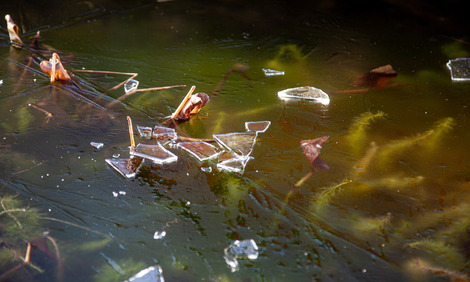Tips for a healthy garden pond
Cold, wind and rain, sometimes even snow - autumn is rushing headlong into winter. In addition to the fascinating palette of colours in our gardens and forests, there’s a lot happening at once at this point, marking the start of one of the most important phases of the year for pond maintenance. If you don’t react, you’ll create problems for the next pond season with algae, cloudy water and, in the worst case, even sick fish.
Now is the time to lay the foundations for a healthy ecosystem. We have put together a checklist with all the tips and topics you need to be best prepared for winter and the coming spring.
1. Feeding at cold temperatures
Feeding in autumn and winter is always a hotly debated topic. The fact is, as long as the fish are active, they need energy. This energy comes from food. So where does the claim that you shouldn't feed come from? In the past, there was simply no suitable food for the cold season. As the temperature drops, the metabolic activity of koi, goldfish and biotope fish also decreases. It is not enough to simply reduce the amount of food. The content of the food has to be adapted so that the necessary nutrients are still available, but also so that digestion is possible at colder temperatures.
Eating behaviour in particular needs to be monitored to ensure that the food is being consumed.
The choice of food in autumn is JBL PROPOND AUTUMN S & JBL PROPOND AUTUMN M for the water temperature range 10 - 20 °C and JBL PROPOND WINTER S / JBL PROPOND WINTER M for water temperatures below 15 °C to 5 °C. If the temperature falls below 5 °C, feeding with the special winter food must also be stopped. If it rises above this value, it is started again.
2. Observe and act during heavy rainfall
Autumn brings plenty of storms and rain. This results in considerable amounts of water, which can also drastically increase the water level in the pond.
Heavy rainfall and wind cause a lot of water from the surrounding area to enter the pond. Heavy pollution is thus just as much an issue as the use of fertilisers.
Rainwater is hardness-free and it dilutes the water, causing a drop in carbonate hardness. In the worst case this can lead to an unstable pH value and a drop in acidity which could kill off all your fish.
Large quantities of water can also change the water temperature abruptly and with the change in pH value it poses a threat to any previously stable bacterial flora.
It is therefore advisable to add JBL BactoPond after long and heavy rainfall to support the pond bacteria. This adds new, strong bacterial cultures to ensure a stable balance.
You also need to secure the stability of the water (you can find out more about this here: Watervoorbereiding ). JBL StabiloPond KH is ideal for this. The powder is evenly distributed in the pond and replenishes the lost minerals. If you still have JBL StabiloPond Basis of the basic care products at home, you can also use this as a substitute.
However, so that you don't have to guess and act blindly, you can easily determine the KH and pH with the JBL PROSCAN and a smartphone (alternatively analogue with JBL PROAQUATEST EASY 7in1 ) or you can use a test set such as the JBL PROAQUATEST LAB koi . This also allows you to determine fertiliser components such as phosphate, iron and nitrate and to identify algae-promoting substances in good time and remove them with suitable measures.
If rainwater enters the pond via a zinc or copper gutter, it is essential to use JBL BiotoPond to bind the metals and prevent the fish from being poisoned.
3. Nutrients from dead plants
Falling leaves, plants dying near the pond and under the water, and the wind all result in a lot of organic material getting into the pond water and slowly decomposing there. This results in an increased nutrient load. Put simply, all the nutrients that were needed to produce leaves, flowers etc. are now released again.
The nutrients this releases remain in the sludge on the substrate and throughout the water. As long as it stays cold and the sun is not too intense, there are hardly any consequences. But in spring many different types of algae develop very quickly. It could be green water, thread algae or brown algae on the liner at the edge of the pond. The sun gives the starting signal and the algae use up the nutrients faster than the plants, which are still slowly adapting to the new season.
It is therefore important to remove the coarse mass of leaves and plant debris before it decomposes. Nevertheless, you can’t prevent it completely. This is where JBL SediEx Pond en JBL PhosEx Pond Direct come in. If you have a large filter, you can also add JBL PhosEx Pond Filter as filter material to continuously bind new nutrients.
In the case of very high phosphate and nitrate levels, large-scale sludge extraction with a 30-50 % water change may be advisable initially before carrying out the procedure described above.
Once algae clusters have formed, it is best to remove them mechanically to eliminate them from your pond’s ecosystem. This rids the pond of the nutrients bound within the algae too.
Tips four to six deal with water testing & monitoring and cleaning & filter care. You’ll find them, along with a checklist for all the products you need, in the second part of this series: The ABC of Pond Maintenance in Autumn / Winter - Part 2 .
